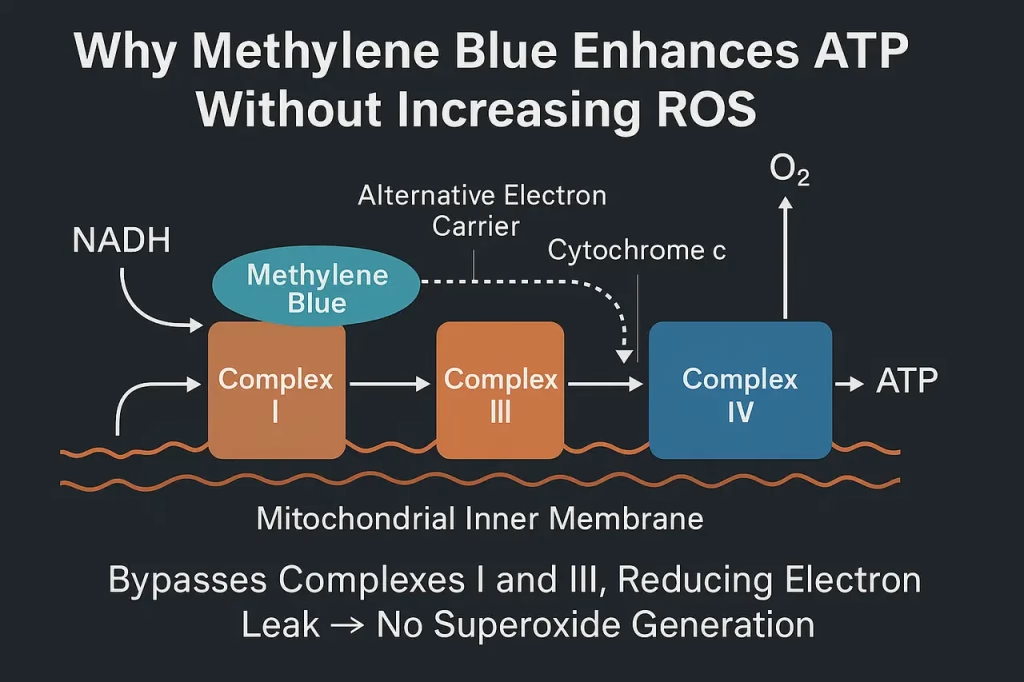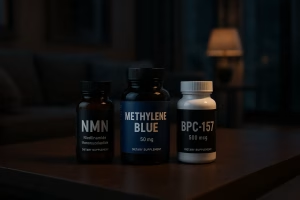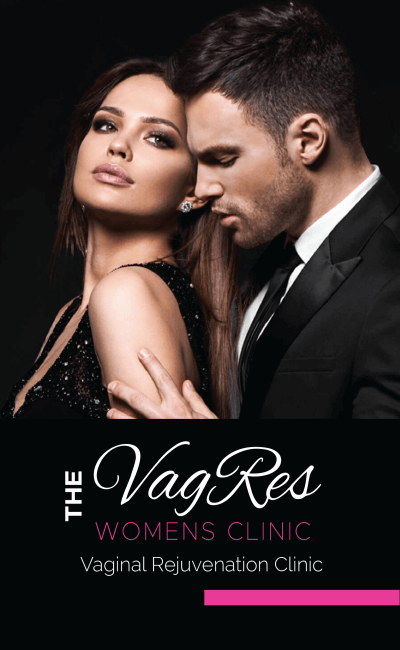Methylene Blue bypasses mitochondrial inefficiencies and enhances ATP synthesis—without increasing reactive oxygen species (ROS). Here’s how it works, backed by science.
🧪 Scientific Mechanism: How MB Boosts ATP Without Elevating ROS
Methylene Blue (MB) acts as an alternative electron carrier in the mitochondrial electron transport chain (ETC), particularly between complexes I and III.
This bypasses complex I deficiencies, where most ROS generation occurs.

Key Mechanism:
- MB accepts electrons from NADH, then directly donates them to cytochrome c
- This results in improved ATP output while reducing the likelihood of electron leak, which is the main source of superoxide (O2•−)
✅ No electron leak = No ROS spike
🔗 Referenced Studies
- Atamna & Kumar (2010)
“Methylene Blue promotes mitochondrial respiration and cellular lifespan via electron cycling.”
PubMed ID: 20547128Live Strong. Age Slow.Reignite your edge with science-backed optimization.Get expert advice tailored to your needs
- Tretter et al. (2014)
“Alternative redox mediators can bypass ETC complex I to reduce ROS.”
DOI:10.1016/j.neurobiolaging.2014.03.013
- Rojas et al. (2012)
“MB enhances brain metabolism in neurodegenerative disease models without elevating ROS.”
PubMed ID: 22459093
🧠 Lücken-orientierte Tiefe (What Others Miss)
Most articles stop at “MB boosts ATP.”
But they miss why it does so without the ROS tax.
This is crucial for those with:
- Mitochondrial disease
- Neurodegeneration
- Chronic fatigue
- Age-related oxidative stress load
⚙️ Biochemical Comparison: MB vs Traditional ETC
| Feature | Traditional Pathway | MB Intervention |
|---|---|---|
| Complex I dependency | Yes | No |
| ROS generation hotspot | High (Complex I) | Low (Bypass via MB) |
| ATP output | Normal / Impaired | Enhanced |
| Electron leak | Frequent | Rare |
| Redox balance | Vulnerable to collapse | More stable |
🧭 Multi-Intent Coverage
✅ For Quick Answers:
Q: Does Methylene Blue increase oxidative stress?
A: No. It reduces ROS by bypassing complex I in the ETC.
🔬 For Experts:
MB operates as a redox cycling agent—accepting electrons at NADH-dependent points and donating at cytochrome c.
This short-circuits the ROS-prone Complex I → CoQ bottleneck.
🧪 For Biohackers & Practitioners:
Use MB (250 mcg–2 mg daily oral) alongside CoQ10, NMN, or BPC-157 to optimize mitochondrial throughput without oxidative backlash.
✅ Summary
Methylene Blue does what few compounds can:
⚡ Boosts ATP production
🧯 Slashes ROS generation
🧠 Protects neurons and mitochondria
And it does it by being smarter than the system it enters—not by pushing it harder.
🧠 Key Studies & Findings
1. Potentials of MB as an Anti-Aging Compound
MB bypasses Complex I/III in the mitochondrial ETC, restoring membrane potential and oxygen consumption—thus boosting ATP while decreasing ROS generation translationalneurodegeneration.biomedcentral.com+15pmc.ncbi.nlm.nih.gov+15gethealthspan.com+15.
2. Deep Dive: MB & Neuroprotection
A 2020 review highlights MB’s ability to enhance mitochondrial respiration, reduce oxidative damage, and improve brain bioenergetics across neurodegenerative models translationalneurodegeneration.biomedcentral.com+1dianarangaves.com+1.
3. Isolated Mitochondria Respiration Study
In rat cardiac mitochondria, MB at 0.1 µM increases oxygen consumption (with Complex I & II substrates) and shows substrate-dependent effects on H₂O₂—lower ROS during Complex II-fueled respiration gethealthspan.com+12pubmed.ncbi.nlm.nih.gov+12sciencedirect.com+12.
4. Alternative Electron Transport Mechanism
MDPI (2020) review confirms MB accepts electrons from NADH/FMN in Complex I and donates directly to cytochrome c—effectively bypassing ROS-producing complexes mdpi.com.
5. Enhanced ATP and Membrane Stability
Studies show MB rescues ΔΨm and boosts ATP in impaired mitochondria, simultaneously lowering ROS production aging-us.com+15sciencedirect.com+15pmc.ncbi.nlm.nih.gov+15.
📚 Additional Supporting Evidence
- Rojas et al. (2012): MB enhances brain metabolism in disease models—supporting ATP increases without ROS spike .
- Gureev et al. (2022): MB but not its metabolite Azure I can bypass Complex I inhibition to restore bioenergetics; Azure I still produces H₂O₂, highlighting MB’s unique ROS‑minimizing action link.springer.com+1gethealthspan.com+1.
🔍 What This Means
- Mechanism: MB functions as an alternative electron shuttle—accepting electrons upstream and donating past major ROS “leak” points—thus reducing electron escape and superoxide formation.
- Outcome: Enhanced mitochondrial efficiency—higher ATP yield, stable membrane potential, and reduced oxidative stress.








